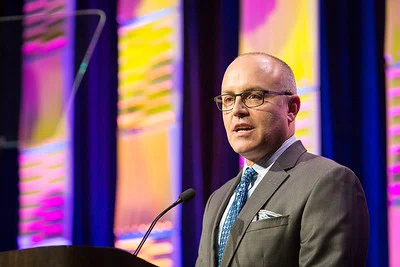newsletter
Sign up for the Marketer QuickLook Newsletter
SMPS Headquarters
625 North Washington Street
Suite 302
Alexandria, VA
22314-1936
email
info@smps.org
phone
703.549.6117



business development
Why Leadership Development Matters Now

By Craig Park and Barbara Shuck
domain

Leadership development is more essential today than ever in the dynamic landscape of AEC professional services. Leadership in professional service firms transcends mere management. It’s about inspiring teams, fostering innovation, and upholding integrity. Inspirational, innovative, and high-integrity leaders are the bedrock of professional service success, creating environments that boost internal and external creativity, ethical behavior, and stakeholder trust. Influential leaders provide a competitive advantage and ensure the organization’s long-term success.
Inspirational Leadership
Inspirational leaders with a clear vision and mission empower their teams, fostering an environment ripe for personal and professional growth. Leaders inspire their teams toward greatness by cultivating vision, empathy, and wisdom, contributing significantly to the organization’s success.
They emphasize goal-setting, strategic planning, and continuous learning, leading to increased profitability and a legacy of trust and constant improvement. Inspired leadership realizes that the role of the leader is the ability to motivate — a mentoring role distinguished by many leaders. Inspiration is the process of stimulating teams to do something special, especially something creative.
Innovative Leadership
Innovation is vital for staying competitive. Leaders who encourage creative thinking and risk-taking drive success. Innovative leaders can define a vision through creative effort that establishes a practice that is unique from its competition. Vision is the entrepreneurial spirit that imbues many celebrated leaders. Innovation expands on inspirational creation by developing and implementing a new process or service to improve efficiency, effectiveness, or competitive advantage.
Leadership Integrity
Similarly, integrity is crucial in setting an organization’s ethical tone. Leaders who prioritize integrity create a culture of trust that is fundamental for a strong business reputation. Leaders with integrity demonstrate their true nature through words and actions. Integrity is the quality of honesty and strong moral principles, achieving being whole and undivided.

A Framework For Growth
We based our approach to personal leadership development on a process that has worked for us in our personal development journey. Using a protocol of awareness, acceptance, and action significantly helped us develop our leadership capabilities. This approach includes:
Step 1: AWARENESS
Developing awareness involves becoming more conscious of one’s thoughts, emotions, behaviors, and impact on others. By promoting self-awareness, leaders better understand their strengths, weaknesses, and areas for improvement, leading to greater effectiveness and better decision-making. Additionally, leaders who are more aware of their biases and assumptions are more inclusive and empathetic in their interactions with others, leading to stronger relationships and a more positive work environment.
Leaders must first know their strengths, weaknesses, team needs, and market dynamics. This awareness is crucial for adapting to economic, social, technological, and political shifts, particularly in sectors like AEC, where operational models must be responsive to diverse client needs.
Step 2: ACCEPTANCE
Acceptance involves acknowledging and embracing one’s strengths and weaknesses. By accepting their limitations, leaders focus on leveraging their strengths and delegating tasks outside their areas of expertise. Additionally, leaders accepting others’ differences foster a more diverse and inclusive workplace culture, leading to increased creativity, innovation, and better problem-solving.
Acceptance involves recognizing the current state of affairs, including its challenges and opportunities. For instance, the “lessons learned” technique in agile and Lean Six Sigma management processes exemplifies how accepting past experiences can improve future performance.
Step 3: ACTION
Action involves using awareness and acceptance to make meaningful changes and improvements. Leaders become more effective and succeed by setting clear goals, creating plans, and taking action. Additionally, leaders who give agency to address issues and challenges in the workplace foster a culture of accountability and continuous improvement, which leads to better outcomes for the firm and its clients.
Finally, action is about implementing strategies that align with the vision and mission of the firm. It involves setting realistic goals, fostering an inclusive and diverse mindset, and promoting a culture of continuous learning and innovation.
Markers On The Leadership Journey
Basing personal development on awareness, acceptance, and action helps leaders and aspiring leaders become more conscious, inclusive, and practical, resulting in a more positive workplace culture and better outcomes for the firm and its clients. Leaders and aspiring leaders use that framework to measure progress by how their actions translate into practice leadership. They include:
- Embracing a Balanced Approach: Successful leaders balance innovation with efficiency. They recognize the importance of adapting to changes while maintaining a familiar foundation.
- Fostering an Iterative Learning Culture: Encourage a culture where every project is a learning opportunity. Adopt techniques like the appreciative inquiry model to optimize the innovation process.
- Prioritizing Integrity and Ethical Behavior: Integrity should be at the heart of leadership development. Leaders must lead by example, fostering a culture of trust and accountability.
- Promoting Inclusivity and Diversity: An inclusive and diverse mindset ensures a rich pool of ideas and a committed team. Recognize the importance of every contribution, whether big or small.
- Cultivating Strong Communication and Relationship Skills: Clear and honest communication is vital, especially in industries where collaboration is critical. Leaders must be adept at framing conversations that align with client needs and managing conflicts effectively.
- Developing a Client-Centric Approach: Understanding and addressing client needs from their perspective is paramount. This approach fosters long-term relationships and builds trust.
- Emphasizing Continuous Improvement: Seek ways to improve personal leadership skills and the team’s overall performance. Encourage feedback and be open to learning from both successes and failures.
- Investing in Leadership Development Programs: Regularly attend leadership training and workshops. These programs provide valuable insights and tools for effective leadership.
- Setting Clear Goals and Expectations: Establish realistic goals and communicate these clearly to the team. Ensure everyone understands their role in achieving these objectives.
- Leading by Example: Leaders must embody the values they wish to see in their teams. Integrity, innovation, and inspiration should be more than words; they should be visible in the leader’s actions.
The Next Steps On Your Leadership Journey
In our research for our new book, The Architecture of Vision: Leadership in Your Professional Practice, we looked closely at why cultivating leadership across all roles within a firm — not just the licensed professions — is crucial to building an enduring practice. We developed a framework based on awareness, acceptance, and action that provides steps and recommendations for embarking on a leadership journey.
Leadership development in professional service firms is a continuous journey that requires a commitment to growth, learning, and adaptation. By embracing the three pillars of leadership —Inspiration, Innovation, and Integrity — leaders can foster an environment that drives success and builds a legacy. The journey is challenging but rewarding, leading to innovative, ethical, and ultimately successful organizations.
ABOUT THE ARCHITECTURE OF VISION
In The Architecture of Vision: Leadership in Your Professional Practice, Park and Shuck share insights from extensive research and input from over 25 AEC industry leaders into the nature of leadership and leadership development, providing a framework based on three pillars: Inspiration, Innovation, and Integrity. Aimed at the needs of firms and aspiring leaders, they provide clear, real-world, contemporary examples of becoming more aware, accepting, and actionable as a visionary leader in a professional service firm. The book provides new insights, direction, and actionable steps to take their careers to the next level.
More information about the book can be found at www.architectureofvision.com.
Share:

Craig Park, FSMPS, Assoc. AIA is an associate principal with architects and engineers, Clark & Enersen, and the president of CraigPark.Consult, a strategic business advisory. Craig is based in Charleston, SC. Craig is an SMPS Fellow, past Society president, past SMPS Foundation Trustee, and the 2007 Weld Coxe Marketing Achievement Award recipient.
Email Craig at
craig@craigpark.com

Barbara Shuck, FSMPS, CPSM, is the president of Everest Marketing Services, a marketing and business development consulting firm based in Mesa, AZ. Barbara is an SMPS Fellow, past Society president, SMPS Foundation Trustee, and the 2022 Weld Coxe Marketing Achievement Award recipient.
Email Barbara at
barbara@everest
marketingservices.com
READ NEXT

























